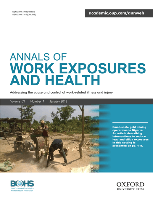
Annals of Work Exposures and Health
Scope & Guideline
Championing open access to vital health research.
Introduction
Aims and Scopes
- Occupational Exposure Assessment:
The journal frequently publishes studies assessing exposure levels to various occupational hazards, including chemical, biological, physical, and ergonomic risks. This includes the development and validation of exposure assessment tools such as job exposure matrices and innovative sampling techniques. - Health Outcomes Related to Work Exposures:
Research focusing on the health impacts of occupational exposures, including chronic diseases, mental health issues, and acute health outcomes, is a core area of publication. The journal highlights studies that investigate the relationships between specific exposures and health effects across different industries. - Intervention Studies and Policy Implications:
Papers that evaluate interventions aimed at reducing occupational exposures and improving worker health are prominently featured. This includes randomized controlled trials, observational studies, and policy analysis, providing insights into effective strategies for occupational health improvements. - Emerging Risks and Technologies:
The journal addresses new and emerging occupational health risks, particularly those associated with technological advancements, such as nanotechnology and artificial intelligence in workplace settings. This includes studies on the implications of these technologies for exposure and risk management. - Cross-disciplinary Research:
Research that incorporates perspectives from various disciplines, including epidemiology, toxicology, psychology, and engineering, is encouraged. This interdisciplinary approach enriches the understanding of occupational health challenges and solutions.
Trending and Emerging
- COVID-19 Related Research:
There is a significant increase in studies focused on the impacts of COVID-19 on workplace health, including infection control measures, mental health implications, and the effectiveness of personal protective equipment (PPE). This trend highlights the urgent need for research addressing health risks associated with pandemics. - Mental Health and Psychosocial Risks:
Research examining mental health issues related to occupational stress, burnout, and workplace violence is on the rise. This reflects a growing awareness of the importance of psychosocial factors in occupational health and the need for comprehensive mental health interventions. - Wearable Technology and Real-Time Monitoring:
The use of wearable sensors and real-time monitoring technologies to assess exposure and health outcomes is gaining traction. Studies exploring the effectiveness of these technologies in improving occupational safety and health management are increasingly featured. - Sustainability and Occupational Health:
Emerging research focuses on the intersection of sustainability practices and occupational health, exploring how environmentally friendly practices can impact worker safety and health outcomes. This theme addresses the growing emphasis on sustainable work practices. - Health Equity in Occupational Health Research:
There is an increasing focus on health equity, examining how socioeconomic factors, race, and gender affect occupational exposures and health outcomes. This trend highlights the importance of addressing disparities in occupational health research and interventions.
Declining or Waning
- Traditional Risk Factors in Isolation:
There has been a noticeable decrease in studies that focus solely on traditional risk factors, such as exposure to specific chemicals or physical hazards, without considering their interactions with other workplace factors or broader health determinants. - Longitudinal Studies with Limited Scope:
Longitudinal studies that only assess a narrow range of health outcomes related to specific exposures, without integrating psychosocial factors or broader occupational health frameworks, appear to be declining in frequency. - Generalized Workplace Safety Protocols:
Research centered on generic workplace safety protocols, without tailoring to specific industries or contexts, is becoming less frequent. There is a growing emphasis on context-specific interventions that address unique challenges faced by different sectors. - Focus on Non-Occupational Health Factors:
There is a waning focus on non-occupational health factors, such as lifestyle and community influences, that impact worker health. The journal is increasingly prioritizing studies that integrate occupational and non-occupational health determinants.
Similar Journals

Occupational Health Science
Promoting effective interventions for optimal worker health.Occupational Health Science, published by SPRINGER NATURE, presents a vital platform for advancing research in the field of occupational health and safety. With an ISSN of 2367-0134 and E-ISSN 2367-0142, this journal addresses critical issues related to worker health, the impact of occupational exposure to physical and psychosocial hazards, and promotes the development of effective workplace interventions. As a valuable resource for researchers, professionals, and students alike, it aims to foster a deeper understanding of the factors affecting occupational health and the efficacy of preventive measures, contributing significantly to the well-being of workers globally. While the journal currently operates under a traditional access model, its rigorous peer-review process and commitment to high-quality research ensure its prominent position in the academic community. Engage with Occupational Health Science to stay at the forefront of this essential discipline and enhance your knowledge and practices in creating safer workplaces.

Environnement Risques & Sante
Exploring the Nexus of Environment and HealthEnvironnement Risques & Sante is a prominent journal focused on the intersection of environmental issues, public health, and safety, offering a platform for scholarly discourse on the critical challenges posed by environmental risks to human health. Published by JOHN LIBBEY EUROTEXT LTD, this journal aims to disseminate impactful research that enhances our understanding of toxicology, mutagenesis, and their implications for public health policy and practices. Though it ceased coverage in Scopus in 2021, its historical contributions remain relevant, addressing urgent topics in environmental science and occupational health. Researchers and professionals engaged in these fields will find valuable insights and findings that inform practice and promote sustainable solutions. For interested readers, further exploration of the journal can provide essential knowledge in coping with contemporary environmental health challenges.

Medicina del Lavoro
Fostering dialogue on critical health issues.Medicina del Lavoro, published by MATTIOLI 1885, is a distinguished academic journal that has been a pivotal resource for the fields of medicine and public health since its inception in 1947. With an ISSN of 0025-7818, this journal focuses on disseminating high-quality research relevant to environmental and occupational health, positioning itself in the Q2 category for both Medicine (miscellaneous) and Public Health, Environmental and Occupational Health. Its notable Scopus ranking places it within the top 69th percentile of its field, reflecting its commitment to scholarly excellence. While the journal is not open access, it offers a range of informative articles, including original research, reviews, and case studies, that are essential for researchers, professionals, and students committed to advancing their understanding of workplace health and safety. With articles converging up to 2024, Medicina del Lavoro continues to illuminate critical issues and foster discussion within the global health community.

INTERNATIONAL ARCHIVES OF OCCUPATIONAL AND ENVIRONMENTAL HEALTH
Pioneering Insights for Safer Workplaces and EnvironmentsINTERNATIONAL ARCHIVES OF OCCUPATIONAL AND ENVIRONMENTAL HEALTH is a prestigious journal published by Springer that serves as a vital resource in the field of public health and occupational safety. With its ISSN 0340-0131 and E-ISSN 1432-1246, this journal has been a cornerstone for researchers and professionals since its inception in 1975, converging knowledge and insights to enhance health practices and policies. Rated in the top Q1 category for both Public Health and Environmental and Occupational Health as of 2023, it currently ranks 154 out of 665 in Scopus, placing it in the 76th percentile, underscoring its significant impact within the scientific community. Although the journal does not offer open access, it provides invaluable content covering various aspects of environmental health, occupational safety, and epidemiological studies, making it a must-read for anyone vested in improving health outcomes across diverse populations. Located in Germany with an office at One New York Plaza, Suite 4600, New York, NY 10004, United States, the journal is committed to advancing knowledge and fostering collaboration among its readership.
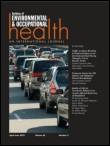
Archives of Environmental & Occupational Health
Exploring the vital connections between work and wellness.Archives of Environmental & Occupational Health is a prestigious journal published by Routledge Journals, Taylor & Francis Ltd, dedicated to advancing research and knowledge in the realms of environmental science, occupational health, and toxicology. With an ISSN of 1933-8244 and an E-ISSN of 2154-4700, this peer-reviewed journal has gained significant recognition, currently holding a Q2 ranking in Environmental Science and Q3 rankings in Health, Toxicology and Mutagenesis, and Public Health. Established in 2005, it serves as a vital platform for researchers, practitioners, and policymakers alike who aim to address and disseminate findings on pressing environmental and occupational health issues. The journal is not open access, allowing for rigorous peer review processes while still reaching a broad readership. As it converges through 2024, the Archives of Environmental & Occupational Health continues to play a critical role in shaping discourse and fostering innovation in the field, making it an essential resource for those committed to improving both human health and the environment.
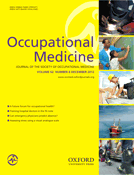
OCCUPATIONAL MEDICINE-OXFORD
Pioneering Research for Healthier Work EnvironmentsOccupational Medicine-Oxford is a leading journal in the fields of public health and occupational health, published by Oxford University Press. With an ISSN of 0962-7480 and an E-ISSN of 1471-8405, this esteemed journal has been disseminating critical research findings since its inception in 1948. Ranked in the Q2 category for both Medicine (miscellaneous) and Public Health, Environmental, and Occupational Health, it occupies a significant spot in the academic community, with a Scopus ranking of #147 out of 665 in its categories, placing it within the 77th percentile. The journal aims to enhance the understanding of occupational health issues and promote practices that improve worker safety and well-being. As a vital resource for researchers, professionals, and students alike, Occupational Medicine-Oxford provides insights into emerging trends, comprehensive reviews, and original research articles that pave the way for future innovations in occupational health strategies. Explore the journal for the latest developments in this critical field, and gain access to a wealth of knowledge that can make a meaningful impact on public health policies and occupational practices worldwide.

OCCUPATIONAL AND ENVIRONMENTAL MEDICINE
Shaping policies through rigorous environmental and occupational research.OCCUPATIONAL AND ENVIRONMENTAL MEDICINE is a leading academic journal dedicated to the field of public health, with a specific emphasis on environmental and occupational health. Published by the esteemed BMJ PUBLISHING GROUP, this journal has established itself as a crucial resource for researchers, professionals, and students alike, achieving a remarkable impact factor that reflects its high-quality research contributions. With a distinguished Q1 ranking in its category and a strong position in Scopus rankings—placing it at #59 out of 665—this journal showcases top-tier studies and findings from 1994 to its anticipated convergence in 2024. Set in the United Kingdom, the journal aims to advance understanding and practices relating to health in the workplace and environmental settings, making it an indispensable platform for the dissemination of knowledge in this vital area. Although not an open-access journal, it provides a valuable repository of articles that influence policy and practice worldwide, ensuring that critical information is accessible to those dedicated to promoting safer, healthier working and living environments.
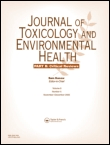
JOURNAL OF TOXICOLOGY AND ENVIRONMENTAL HEALTH-PART B-CRITICAL REVIEWS
Bridging the gap between research and real-world impact.Welcome to the JOURNAL OF TOXICOLOGY AND ENVIRONMENTAL HEALTH-PART B-CRITICAL REVIEWS, a prestigious publication under TAYLOR & FRANCIS INC based in the United Kingdom. With an impressive impact factor and ranked in the Q1 category for both Health, Toxicology and Mutagenesis, and Toxicology, this journal provides critical insights into the fields of toxicology and environmental health. Since its inception in 1998, it has become a key resource for researchers, professionals, and students, offering rigorous peer-reviewed articles that synthesize and critically appraise current knowledge in the discipline. The journal is recognized globally, ranking #5 in Toxicology and #12 in Environmental Science according to Scopus, highlighting its crucial role in advancing research and understanding in these essential areas. The journal also embraces open access options, making it easier for a broader audience to access vital research findings. Engage with the latest developments and critical analyses that are shaping the future of environmental health and toxicology by exploring our comprehensive collection of reviews and articles.
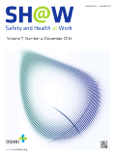
Safety and Health at Work
Elevating safety research for a sustainable future.Safety and Health at Work is a prominent academic journal published by Elsevier, dedicated to advancing the fields of safety research, public health, and occupational health. Since its inception in 2010, the journal has established a robust Open Access platform, allowing for a wide dissemination of high-quality research aimed at improving safety standards and health practices globally. Based in South Korea, the journal is housed at RADARWEG 29, 1043 NX AMSTERDAM, NETHERLANDS, and has garnered a notable reputation with an impressive ranking in various categories, achieving Q1 status in Safety Research and Q2 in related fields such as Public Health and Chemical Health and Safety. With an impact factor reflective of its influence—ranking within the top percentiles of Scopus in Safety and Chemical Engineering—the journal serves as an essential resource for researchers, professionals, and students committed to fostering safer and healthier workplace environments. The convergence of multiple disciplines enriches its contributions, making it a vital platform for innovation and collaboration in safety practices and policies.
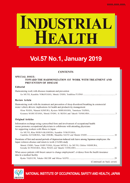
INDUSTRIAL HEALTH
Transforming Knowledge into Action for Worker SafetyINDUSTRIAL HEALTH is a premier journal dedicated to the dissemination of innovative research in the fields of public health, environmental and occupational health, as well as toxicology and mutagenesis. Published by the National Institute of Occupational Safety and Health in Japan, the journal has been a critical resource for over six decades, covering essential topics from 1963 to the present day. With an impressive placement in the second quartile (Q2) of the Public Health, Environmental and Occupational Health category and a third quartile (Q3) in Health, Toxicology, and Mutagenesis, it is recognized for its significant contribution to advancing knowledge and improving practices within the industry. While not an open-access journal, INDUSTRIAL HEALTH offers researchers and students access to a wealth of knowledge through its rich archive of articles, fostering a deeper understanding of health and safety challenges in industrial settings. The journal’s dedication to high-quality research and its strategic role in promoting occupational safety make it an invaluable asset for professionals seeking to enhance health standards and safety protocols worldwide.